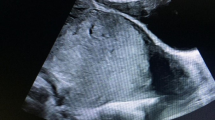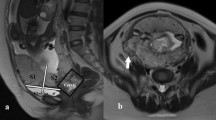Abstract
The purpose of this study was to compare the value of pelvic ultrasound with color Doppler and magnetic resonance imaging (MRI) in: (1) the diagnosis of placental adhesive disorders (PADs), (2) the definition of the degree of placenta invasiveness, (3) determining the topographic correlation between the diagnostic images and the surgical results. Fifty patients in the third trimester of pregnancy with a diagnosis of placenta previa and at least one previous caesarean section underwent color Doppler ultrasound (US) and MRI. The sonographic and MRI diagnoses were compared with the final pathologic or operative findings. Outcomes at delivery were as follows: normal placenta (n = 38) and PAD (n = 12). MR and US Doppler showed no statistically difference in identiyfing patients with PAD (P = 0.74), while MRI was statistically better than US Doppler in evaluating the depth of placenta infiltration (P < 0.001). MRI accurately characterized the topography of invasion in 12/12 (100%) of the cases, while US accurately characterized the topography of invasion in 9/12 (75%) of the cases. In conclusion, we confirmed that pelvic US is highly reliable to diagnose or exclude the presence of PAD and found MRI to be an excellent tool for the staging and topographic evaluation of PAD.





Similar content being viewed by others
References
Wu S, Kocherginsky M, Hibbard JU (2005) Abnormal placentation: twenty-year analysis. Am J Obstet Gynecol 192:1458–1461
Miller DA, Chollet JA, Goodwin TM (2007) Clinical risk factors for placenta previa-placenta accrete. Am J Obstet Gynecol 177:210–214
Zelop CM, Harlow BL, Frigoletto FD Jr, Safon LE, Saltzman DH (1993) Emergency peripartum hysterectomy. Am J Obstet Gynecol 168:1443–1448
O’Brien JM, Barton JR, Donaldson ES (1996) The management of placenta percreta: conservative and operative strategies. Am J Obstet Gynecol 175:1632–1638
Chou MM, Ho ESC, Lee YH (2000) Prenatal diagnosis of placenta previa accreta by transabdominal color Doppler ultrasound. Ultrasound Obstet Gynecol 15:28–35
Kim JA, Narra VR (2004) Magnetic resonance imaging with true fast imaging with steady-state precession and half-Fourier acquisition single-shot turbo spin-echo sequences in cases of suspected placenta accreta. Acta Radiol 45:692–698
Warshak CR, Eskander R, Hull AD, Scioscia AL, Mattrey RF, Bernirschke K, Resnik R (2006) Accuracy of Ultrasonography and Magnetic Resonance Imaging in the diagnosis of placenta accreta. Obstet Gynecol 108:573–581
Finberg HJ, Williams JW (1992) Placenta accreta: prospective sonographic diagnosis in patients with placenta previa and prior cesarean section. J Ultrasound Med 11:333–339
Palacios Jaraquemada JM, Bruno CH (2005) Magnetic resonance imaging in 300 cases of placenta accreta: surgical correlation of new findings. Acta Obstet Gynecol Scand 84:716–724
Bernirschke K, Kaufmann P (2000) Pathology of the human placenta, 4th edn. Springer, New York
Comstock CH, Love JJ, Bronsteen RA, Lee W, Vettraino IM, Huang RR et al (2004) Sonographic detection of placenta accreta in the second and third trimesters of pregnancy. Am J Obstet Gynecol 190:1135–1140
Ito T, Katagiri C, Ikeno S, Takahashi H, Nagata N, Terakawa N (1999) Placenta previa increta penetrating the entire thickness of the uterine myometrium: ultrasonographic and magnetic resonance imaging findings. J Obstet Gynaecol Res 25:303–307
Chou MM, Tseng JJ, Ho ES (2002) The application of three-dimensional color power Doppler ultrasound in the depiction of abnormal uteroplacental angioarchitecture in placenta previa percreta. Ultrasound Obstet Gynecol 19:625–627
Lerner JP, Deane S, Timor-Trisch IE (1995) Characterization of placenta accreta using transvaginal sonography and color Doppler imaging. Ultrasound Obstet Gynecol 5:198–201
Comstock CH (2005) Antenatal diagnosis of placenta accreta: a review. Ultrasound Obstet Gynecol 26:89–96
Levine D, Barnes PD, Edelman RR (1999) Obstetric MR imaging. Radiology 211:609–617
Maldijan C, Adam R, Pelosi M, Pelosi MI, Rudell RD, Maldijan J (1999) MRI appearance of placenta percreta and placenta accreta. Magn Reson Imaging 17:965–971
Levine D, Hulka CA, Ludmir J, Li W, Edelman RR (1997) Placenta accreta:evaluation with color Doppler US, power Doppler US, and MR imaging. Radiology 205:773–776
Lax A, Prince MR, Mennitt KW, Schwebach JR, Budorick NE (2007) The value of specific MRI feautures in the evaluation of suspected placental invasion. Magn Reson Imaging 25:87–93
Lam G, Kuller J, McMahon M (2002) Use of magnetic resonance imaging and ultrasound in the antenatal diagnosis of placenta accreta. J Soc Gynecol Investig 9:37–40
Taipale P, Orden MR, Berg M, Manninen H, Alafuzoff I (2004) Prenatal diagnosis of placenta accreta and percreta with Ultrasonography, Color Doppler, and Magnetic Resonance Imaging. Obstet Gynecol 104:537–540
Thorp JM Jr, Councell RB, Sandridge DA, Wiest HH (1992) Antepartum diagnosis of placenta previa percreta by magnetic resonance imaging. Obstet Gynecol 80:506–508
Bakri YN, Rifai A, Legarth J (1993) Placenta previa-percreta: magnetic resonance imaging findings and methotrexate therapy after hysterectomy. Am J Obstet Gynecol 169:213–214
Chan JK, Morrow J, Manetta A (2003) Prevention of ureteral injuries in gynecologic surgery. Am J Obstet Gynecol 188:1273–1277
Author information
Authors and Affiliations
Corresponding author
Rights and permissions
About this article
Cite this article
Masselli, G., Brunelli, R., Casciani, E. et al. Magnetic resonance imaging in the evaluation of placental adhesive disorders: correlation with color Doppler ultrasound. Eur Radiol 18, 1292–1299 (2008). https://doi.org/10.1007/s00330-008-0862-8
Received:
Revised:
Accepted:
Published:
Issue Date:
DOI: https://doi.org/10.1007/s00330-008-0862-8




